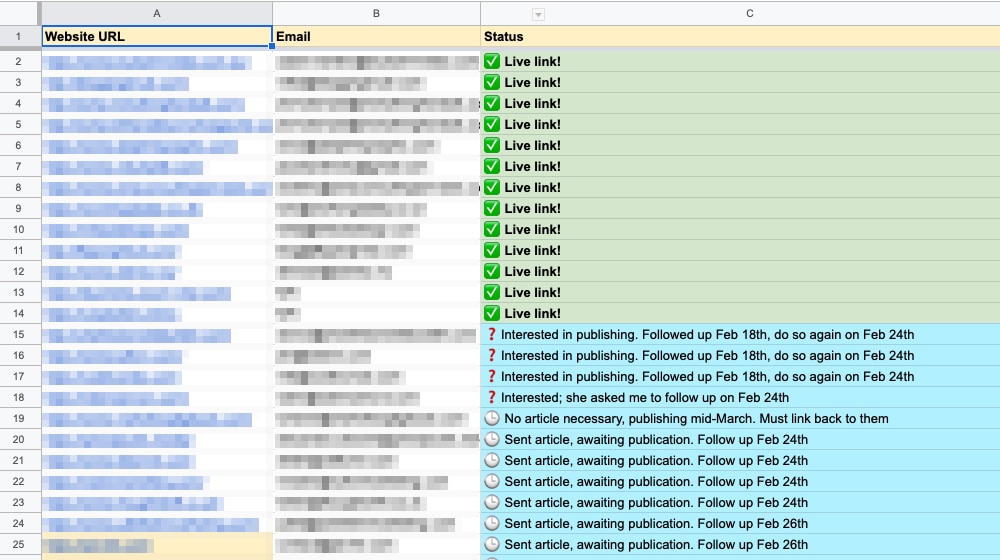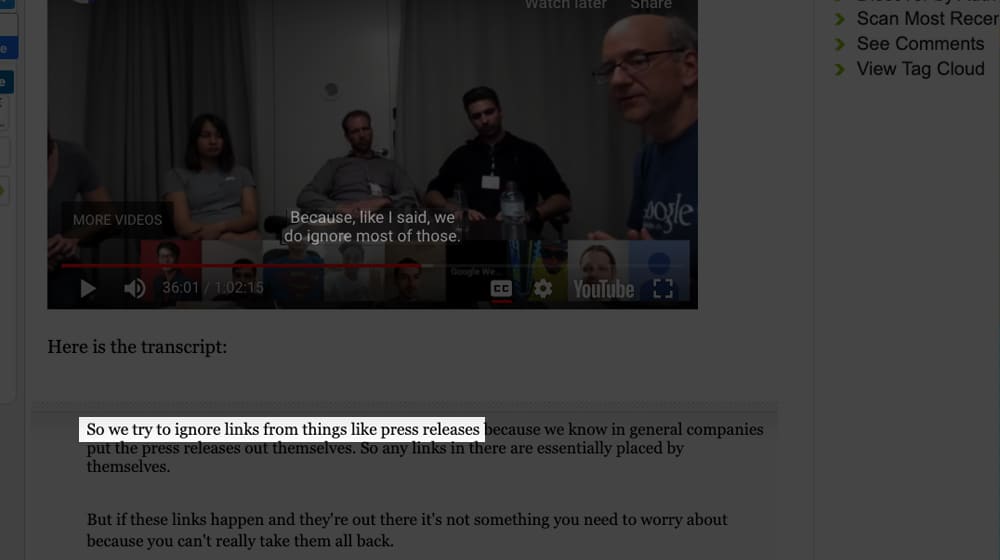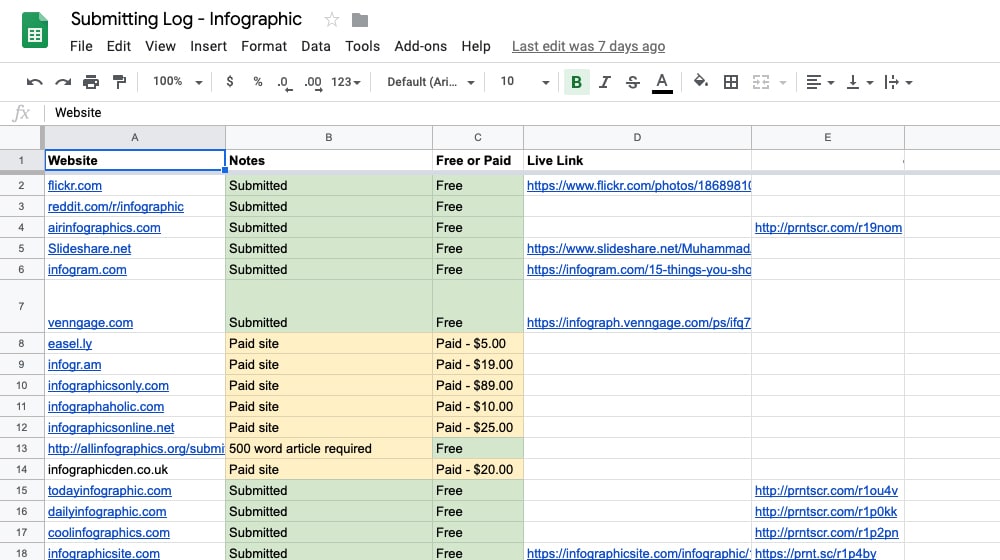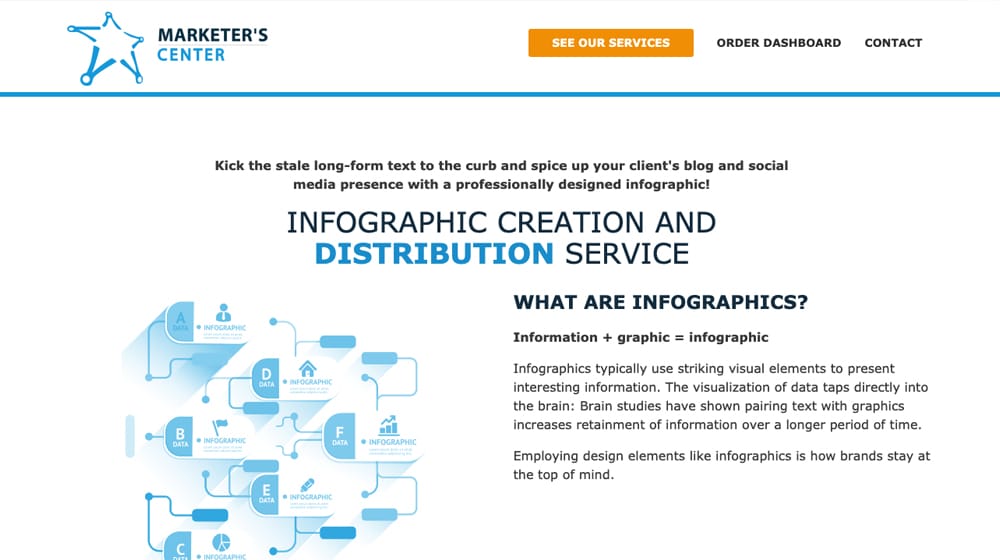Complete List of Infographic Distribution and Placement Services

One of the better strategies for marketing that hasn't been entirely beaten into the ground over the last few years is infographic marketing. Doing an original study with some data aggregation, presenting your conclusions in a compelling graphical format, and sharing that infographic throughout the web is a great way to get backlinks, mentions, and exposure throughout the blogosphere.
The trouble is, it's a ton of work. A ton! Even just identifying all the various sites you can send your infographic to is a time-consuming task. It's worth it to register for some of the big SEO tools like Ahrefs just to find those kinds of sites, and then it becomes not just a ton of work, but costly as well.
Of course, there are plenty of services out there that will do the legwork for you. You pay them a fee and they send out your infographic to however many dozens, hundreds, or thousands of sites they know of in their network who might be willing to publish an infographic. If they work, they might work well, but if they don't, you're spending money on fruitless placement. So what's out there? I've made the list, but it'll be for you to judge.
 30 Second Summary
30 Second Summary
You can promote your infographic with several methods based on your budget and goals. If you want quality placements and have time, you can do manual outreach yourself - this lets you build personal connections but requires extensive work finding contacts and crafting custom emails. For a hands-off approach, you can hire agencies like Fat Joe ($50+ per placement), Growth Gorilla ($3,000 monthly) or high-end firms like Brandpoint. You'll find freelancers and Fiverr sellers offering cheaper options, but watch out for low-quality placements on private blog networks.
Option: Manual Outreach
To use a baseline for comparison, I've been doing a lot of manual outreach recently for my own infographic. That's how I know it can be a lot of work, and how I know it can be expensive when you start registering for tools to help along the way. A lot of those tools have a few weeks or a month of free trial available, but infographic outreach often takes months, not just a few weeks.

Manual outreach is by far the best method for quality placement, if you don't have a huge budget to spend. You get that personal connection with all of the sites you reach out to, and you can interact with them directly rather than through an intermediary. Your infographic can then appear on sites it wouldn't normally, because of that connection.
The downside? It takes forever. You need to scrape gigantic lists of potential targets for outreach, analyze them for various site metrics to pick out the good ones, find contact information for the relevant editors on those sites, investigate them for specific submission methods, and craft customized outreach emails to all of them. Using tools at any point to speed up the process generally costs money, and it's not always an insignificant amount of money.
I don't blame you for wanting another option, I just thought I'd give you the baseline impression before I start showing you what I've found in my own searching.
Option: Press Releases
Press release marketing is a different form of outreach than your usual outreach. There are dedicated press release marketing firms out there who will distribute a press release you write to everything from "bob's press release depot" to the Associated Press website itself. Obviously, finding good distribution channels is going to take plenty of effort.
Press releases have one benefit, which is you only need to write it once. You write a single, well-crafted press release for your infographic, attach the graphic itself, and send it out. Normal outreach typically requires writing dozens of unique articles to accompany the graphic you send out.
On the other hand, press releases often just end up published to an audience of no one. A lot of small-time sites that publish press releases just publish them wholesale, and as such, don't offer any unique value to attract an audience. Sure, some huge sites publish press releases, but just as many will take a press release and send their own writers off to research it. Most of the time, they choose not to cover the story.

There's also the fact that Google largely ignores press releases for SEO. It's one form of duplicate content they can't outright punish, but they can make them minimally valuable for SEO. Press release links end up nofollowed, the releases themselves lose any inherent rank juice, and you just have to rely on them building awareness and getting other people to organically cover your infographic instead. All in all, it's quite a bit less reliable, but at least it's relatively easy.
Option: Fiverr
Fiverr is a strange platform these days. On the one hand, it spent years rightfully earning its reputation as a hub for nothing more than ultra-cheap borderline-worthless services and scams. Writers producing 2,000 words for $5 are probably stealing or spinning it, graphic designers are using templates or stealing assets, coders are producing some of the worst code you've ever seen, and so on. No one doing something for $5 is putting more than half an hour's work into it, at least not if they're smart.

Fiverr worked to combat this by adding additional upsells, where a seller could have a core service for $5 and add-ons that make it better for an additional $5-$10-$20 etc. Writers would write 100 words for $5 and allow you to pay for an additional $5 for every additional 100 words you wanted. Prices end up harder to calculate, but more reasonable for services, so there's actually some gold on the platform now.
Unfortunately, the outreach doesn't result in many placements. There are plenty of people who will get you anywhere from 5 to 1,000 placements for $5, but there are problems:
- Most of the placements don't result in a link, and some don't result in a credit at all.
- The placements that do result in a link are often low-value, no-value, or PBN sites.
- Trying out several different sellers can result in overlap as multiple sellers use similar distribution networks on their end.
As such, Fiverr really isn't a great option for outreach, despite being a popular place for people to start.
Option: Freelancers
Another option you have is to go to a site like Freelancer or Upwork and hire a freelancer to do some outreach for you. You basically outsource your outreach. $100 might get you submission to 100-200 sites.

The trouble with this is that most of these freelancers have limitations. Some of them are just going to write one email and send it off to the entire list. Some of them are more willing to write individualized emails, but require you to do the legwork to provide them with the websites to contact. Some of them will only handle 20-30 sites for that $100. There's a lot of variability here.
I'm not going to discount the possibility that you can find a good freelancer to do the work for you, but what you're really looking for is a virtual assistant. Also, freelancers aren't as likely to be compelling, able to make deals, or promise future engagement that you may be able to. A lot of your high value targets won't respond, so your links end up lower quality.
Option: Agencies
Agencies are generally going to be your go-to option if you want to do skilled outreach but don't want to handle it yourself. Agencies will generally take your goal – promoting your graphic – and your graphic, and will handle everything else from there.
Agencies have a few benefits. For one thing, they have staff who have experience with exactly this kind of outreach. They know how to write a compelling email, they know how to write content to accompany a graphic if need be, and they know what makes outreach successful.
Agencies also have the benefit of having established networks of contacts. All the big name sites in their covered niches are familiar with the agency, and the agency probably has a direct line to the editors who really matter. They can get content published where your own personal outreach might not.
The trouble here is that, well, there's a lot of variance in agencies. Some agencies have excellent, top-tier outreach with great connections on some of the best sites on the internet. Some agencies use 90% private blog networks and get you links from sites that pass virtually no SEO value, have low or no audience, and may disappear at the drop of a hat.
So what agencies are out there? I've definitely found several while I've been doing my own promotion.
Fat Joe
Fat Joe. Fat Joe is an outreach outsourcer aimed at small businesses and new brands that want to build a blog. They do link building, they have content creation services, they have some SEO tools, and they do infographic outreach.
It's a pretty simple service. They "scour the web" looking for websites they can submit your infographic to. They write some minor supporting content, usually around 100-300 words to go along with it, unique for the placement. Then, once the graphic is published and live, they record it in your dashboard so you can see how your placements are going.

Fat Joe is also pretty cheap for outreach. You pay per placement, with the cheapest rates being $50 for the cheapest placement. The only sketchy part, to me, is the categorization of those placements. They divide it not by niche, or by quantity, but by site rankings. Specifically, it's based on Moz site ranks, Ahrefs domain ranking, and other similar metrics.
What this means is that the cheaper placements are going to be low quality sites, the mid-range placements are going to be low-to-middling sites, and the high price placements are going to be the only actually valuable sites.
I didn't use Fat Joe for my outreach, but I'm not going to say you shouldn't. Just know that despite offering low priced plans, you're generally going to want to pay for the top one. I also highly recommend doing some test links before investing in bulk, despite the bulk discounts. Test the kinds of links they get you before going all-in.
To be thoroughly honest, I suspect Fat Joe is a "don't-call-it-a-private-blog-network" company that markets PBN links. That's a personal opinion, though, but judging from the quality of links they produce, I wouldn't be surprised. Also, I'm not the only one that suspects this.
Brandpoint
Brandpoint. Brandpoint is a high-end marketing agency that works with mid- and large-sized businesses to promote content, generate traffic, bring in leads, and perform outreach. They can handle everything from content creation and graphic design to content distribution and even MAT releases. MAT releases are cool because they can even be print distribution, and who wouldn't want to see their killer infographic in print in a major newspaper or magazine?

Brandpoint's MAT release outreach typically generates hundreds if not thousands of placements, and many of their placements are with big-name organizations, either on their blogs, in magazines, in newspapers, and other such locations.
There's just one downside, and it's one you already expect if you're experienced with this industry. Brandpoint is expensive. They're "we don't broadcast pricing publicly" expensive, which you know usually means their clients are spending thousands of dollars a week – or a day – on their outreach and marketing. You can, of course, feel free to contact them and see what they have on offer, but don't be surprised if they're outside your budget.
Growth Gorilla
Growth Gorilla. Growth Gorilla is an outreach and link building agency. Their aesthetic is novel, to say the least, but their services are legit. They put some serious effort into analyzing your site and your content before they even begin their outreach, so they know what you have, they know what you want, and they know what you need.

What's cool here is that they give you a pretty detailed rundown of their entire process before you even sign up for their service. You can see that it's largely the same kind of outreach you'd be doing on your own, with the scraping and analysis and filtering to find websites to even begin with the outreach.
Growth Gorilla has a pretty solid service at the core of their business model, and they tend to work equally well with both small and large businesses. The trick is, their pricing tends to eliminate the smallest businesses from the running. They have a $3,000 per month retainer you need to pay for their services, so it's not really something you can do for a one-off infographic and get your money's worth. However, using an infographic as a seed to try out their service, and keep on afterwards with other promotion, is a perfectly viable plan.
Marketer's Center
Marketer's Center. Marketer's Center is an link and citation building company with outreach and promotion services available as well. Infographic promotion is just one facet of their operations.

If you're not already prepared with an infographic of your own, this company does a great job of creating one for you. The examples they give of infographics they've created are pretty stellar, if I do say so myself. You don't even need to have an idea of what you want your infographic to be about; they can look at your site and your niche and come up with one themselves.
One of the best benefits of Marketer's Center is that their pricing is quite reasonable. Their services are priced low because they're designed to be an agency you resell with your own marketing agency. Getting it direct from the source means your pricing is quite cheap, for service that's good enough to resell. As always, of course, test it out to make sure it works well enough for you, though.
Your Turn
Here's my question to you: have you ever promoted an infographic before? If so, tell me your story in the comments. I'm curious what kinds of services people have used, what tools they use for manual outreach, and what kind of success rates they've had. Infographics are one of the most potentially viral pieces of content out there, because they're easy to consume and easy to share.
What was your biggest roadblock with the entire outreach process? What kinds of issues have you had along the way? Let me know!



 30 Second Summary
30 Second Summary



July 29, 2020
I did try almost everything in this list even the manual outreach. I did not go for Agencies though as it is expensive for most of my clients. Outsourcing people in Upwork and Freelancer gave me the worth of my investment with 70-80% results I’m looking for. The hard part is getting the right freelancer to work for you. I would say, put your eggs in different baskets to compare results.
July 30, 2020
Thanks for commenting! Which method worked best for you for quality placements? I like using Upwork and Freelancer for submitting infographics to all of those free infographic directories since it can be time-consuming and repetitive, but have you used freelancers on those sites for any other purposes?
October 08, 2020
I tried manual outreach when I first started but it was so time consuming, after a few months I hired a freelancer to do the job for me. Most of the links they are getting me are nofollow which is unfortunate so I'm looking into other options. Do you have any idea or any rough estimate of how much it cost to do it right or advice for me?
October 12, 2020
Hi Carole!
That tends to be the problem with infographic outreach, a lot of your links from the top sites are going to be nofollowed.
This isn't necessarily a bad thing if it's increasing their visibility.
Reddit, for example, nofollows all links on their site, but getting on the front page could result in thousands of dofollow organic links from other sites.
As far as doing it the right way / how much it will cost, the best way to promote an infographic is manual outreach.
It's tedious, tricky, and oftentimes expensive. While it's effective, it's also inefficient in that you'll have to contact a lot of bloggers before you get any that will bite. Most bloggers are conditioned to ignore these kinds of emails.
You'll also get replies from people who charge money for placements, which you have to be careful of as well.
You could potentially be penalized, and even if you aren't, the fee for that link may not be proportionate to the value.
I've seen estimates of people that offer this range between $1500-3000+ per month with an average of 10-30 links acquired per month.
Doing it yourself is always cheaper, but you run the risk of having your email marked as spam and being blacklisted.
That's why you'll see a lot of these outreach emails originating from new domains that were registered as disposable domains in case this happens.
If this sounds like a lot, you can always just write a really great article to accompany your infographic. If you had a 2,000-3,000 word article breaking down every part of your infographic, and you have a strong topic, then you can rank really well organically without any links. If you have enough visitors landing on your infographic, a handful of them are bound to share it. You can add an embed code on your infographic as well to make it easier for your organic visitors to link to, like on our infographic here: https://www.contentpowered.com/blog/infographic-blogging-in-2020/
Hope this helps 🙂
May 18, 2021
My problem is I don't have enough time to do infographic distribution correctly. There's so much emailing required and toools that are needed. It's a big pain.
May 19, 2021
Hey Adrian!
It is a pain - you almost need to hire an expert who can help with that specifically.
Tools like Scrapebox, Screaming Frog, Ahrefs, a bulk emailing and follow-up sequence tool, are all required.
There are spreadsheets, negotiation for those that require reciprocal links or a small fee - it's a ton of work.
It works, though. It just takes a lot of time to do correctly. We've had a couple of infographics go viral in the past, but they take so much work to create and promote that we're not doing them as much these days.